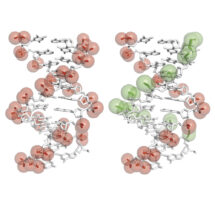
DNA and RNA both have a highly negatively charged backbone and it was widely believed that such a charged structure is essential for their function as information storage molecules. Philipp Holliger’s group, in the LMB’s PNAC Division, in collaboration with researchers at NIH in the USA and at IRB in Barcelona, have challenged this conjecture by producing a DNA-like genetic polymer that is both uncharged and can store and transfer genetic information. These new polymers may lead to novel applications in biotechnology and medicine and have implications for the chemical requirements for life on Earth and on other planets.
A negative charge on the backbone of every nucleotide ensures that this property is the same across all DNA molecules, regardless of the specific sequence of nucleotides that makes up any particular gene. This decouples chemical properties that are affected by charge, such as solubility, from the information content held within the sequence of nucleotide bases. As a consequence all genes and genomes will have the same chemical properties regardless of their sequence. These notions led to the hypothesis that a charged backbone must be essential for any genetic molecule including DNA and RNA.
To investigate whether charge is indeed an absolute functional requirement for genetic function, Sebastian Arangundy-Franklin, a researcher in Philipp’s group, first made artificial nucleic acids that would be able to form an uncharged DNA-like chain, called alkylphosphonate-nucleic acid, or phNA. As natural polymerases (the enzymes that make DNA and RNA chains) cannot use these artificial nucleic acids, he also had to engineer a new polymerase through processes of design and laboratory evolution. They were then able to copy DNA into the uncharged phNA strand and later recover this information back into DNA, showing that uncharged polymers can function as a genetic store of information.
Furthermore, the researchers also found that strings of phNA could themselves be evolved to bind to proteins with high specificity and affinity, just as antibodies do. This property of antibodies has led to their widespread use throughout research and medicine, so it is possible that these new polymers might also lead to novel applications in biotechnology and therapeutics. The development of methods for producing and evolving these phNA polymers provides an important new tool for synthetic biology.
As uncharged molecules can be soluble in liquids other than water – for example organic solvents – the demonstration of an uncharged polymer that can function as a genetic molecule, suggests that lifeforms dependent on similar such systems might be able exist in unexpected places, like the liquid methane lakes on Saturn’s moon Titan.
The work was funded by the MRC, BBSRC, NICHD/NIH Intramural Research Program, EMBO, IRB, the University of Barcelona, and a Trinity College Cambridge fellowship.
Further references
A synthetic genetic polymer with an uncharged backbone chemistry based on alkyl-phosphonate nucleic acids. Arangundy-Franklin, S., Taylor, AI., Porebski, BT., Genna, V., Peak-Chew, S., Vaisman, A., Woodgate, R., Orozco, M., Holliger, P. Nature Chemistry
Philipp’s group page
Roger Woodgate’s page
Modesto Orozco’s page